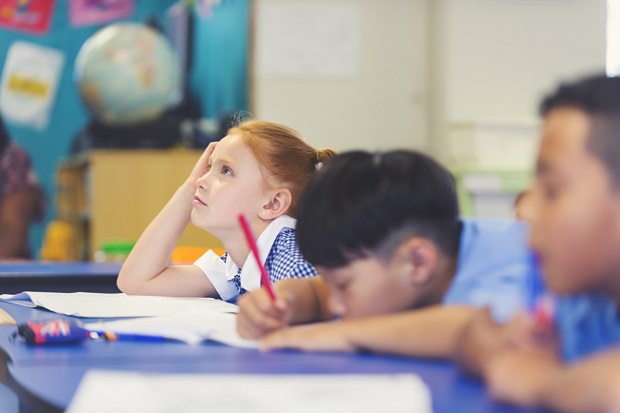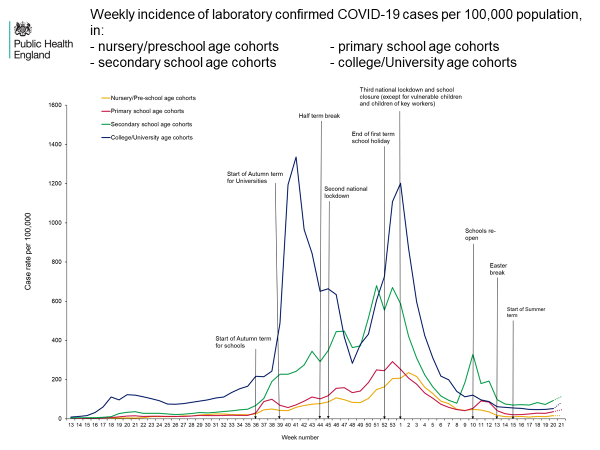
In the weeks following the full re-opening of schools, COVID-19 outbreaks linked to school settings and cases among school age cohorts have remained low and broadly reflected what is happening in the wider community.
As 9 million pupils across the country returned to face-to-face education in March, we saw only a very small increase in cases among 5 to 9 and 10 to 19-year olds. Monitoring positivity rates, using multiple data sources, provided reassurance that this increase was minimal given the huge number of children returning to schools, and crucially did not signal an overall rise in COVID-19 infection in children.
Whenever we re-open an element of society, there will be an increase in physical movement and social contact, so we anticipate some increase in COVID-19 cases. Whilst schools have been open, we have also had an intensive testing programme in place to help detect more cases among staff and pupils.
Thanks to the extraordinary efforts of teachers and staff to implement a system of controls and also to parents and pupils for following COVID-19 rules and guidance, as well as the participation of staff, pupils and families in mass testing programmes, schools have been able to provide face-to-face education in the safest way.
Our children have been learning together again in schools – environments which we know are so crucial to their physical and mental well-being.
Putting the data in context
Reporting even a small increase in COVID-19 cases may appear concerning but it's important to understand the data in context. COVID-19 data nationally demonstrate the impact of the vaccination and mass testing programmes.
Case rates are falling in vaccinated adults, and mass-asymptomatic testing among young people is helping detect cases that would not otherwise be found and preventing the virus from entering schools. Infection and outbreak trends in schools have remained consistent with the expectations of public health and education experts and in line with what is happening nationally.

Studying rates and transmission
We continue to gather scientific data on COVID-19 from our schools’ surveillance and studies. The Schools Infection Survey (SIS) study, jointly led by PHE, the Office for National Statistics (ONS) and the London School for Hygiene and Tropical Medicine (LSHTM), the Surveillance in Schools Kids (sKIDs), as well as our weekly surveillance data have shown that both infections and transmission in schools remain very low. Our studies and data have also shown that case rates within schools reflect those of the wider community.
The latest round of the Schools Infection Survey conducted between 15 – 30 March 2021 showed that current infection rates in secondary school pupils and staff were significantly lower than rates recorded in November 2020. Antibody testing also showed that the rate that the antibody positivity rates in school staff have remained the same as or lower than adult antibody positivity rates in the community, providing further evidence that schools are not hubs of infection in the current pandemic.
Keeping children and schools safe
In children and young people symptoms are often absent or very mild and so testing plays an important role in reducing asymptomatic pupils and staff with COVID-19 attending education settings and potentially spreading the virus.
Within schools, effective systems of control remain in place to reduce transmission. Guidance on face coverings has now relaxed to help provide maximum learning benefits for children whilst measures such as hand hygiene, reduced social contact and good ventilation continue to play an important role in protecting young people and staff
- Ensuring that individuals who are required to self-isolate do not attend school.
- Advising everyone to clean their hands thoroughly and more often than usual.
- Ensuring good respiratory hygiene by promoting the ‘catch it, bin it, kill it’ approach
- Maintaining enhanced cleaning on site.
- Minimising contacts across the school and maintaining social distancing where possible, including creating bubbles etc.
- Wearing appropriate PPE where necessary.
- Keeping occupied spaces well ventilated.
- Rolling out mass asymptomatic testing programmes for all staff and secondary school-age students.
- Face coverings can be re-introduced as a temporary measure on the decision of Directors of Public Health through the Local Action Committee structure in response to local outbreaks and variants of concern.
Variants
It is understandable that the emergence of new variants of COVID-19 may cause anxiety and concern.
All viruses mutate and there is currently no evidence that variants cause more serious symptoms in children or young people. COVID-19 infections due to any variant remain uncommon in school-aged children and reassuringly, children and young people rarely become seriously ill following COVID-19 infection.
Our school studies and surveillance programmes are on-going and we continuously monitor the science carefully. We have also been working to enhance our surveillance systems to provide clear and robust data on variants linked to outbreaks in educational settings.
The latest PHE data suggest that there have been 97 confirmed COVID-19 outbreaks in primary and secondary schools that have had at least one variant case linked to them over the most recent 4-week period. This represents around 1 in 250 schools.
Keep testing
During the May half-term, renewed freedoms will have been welcomed and enjoyed by many children and young people who will have been able to meet up together.
To ensure we continue moving in the right direction and reduce the risk of COVID-19 entering our schools we urge families to carry on testing as children return to school. Testing remains an important part of our overall strategy to get our lives back to normal. Everyone’s efforts together can ensure we keep going.
You can subscribe to our blog to receive updates on new posts here.

1 comment
Comment by JUSTUS posted on
To improved health of communities around the schools by preventing waste - related diseases, because waste has significant negative impacts on the environment